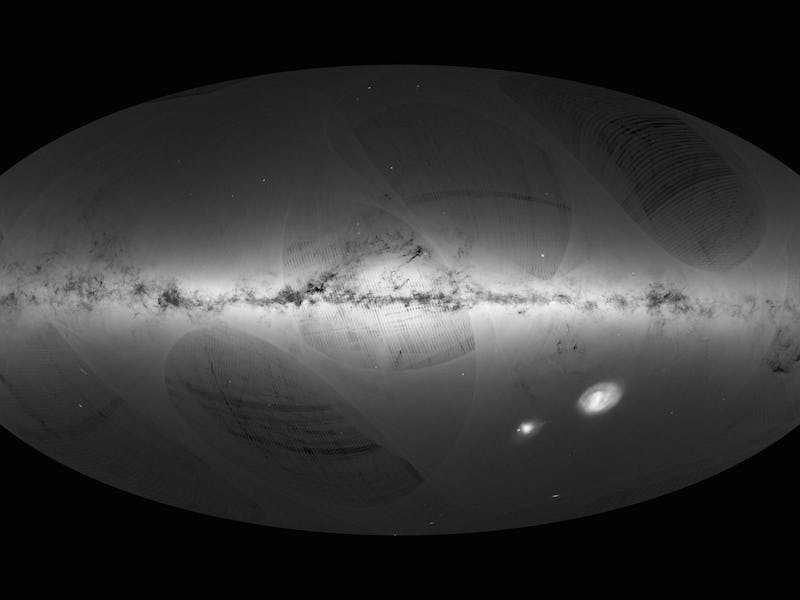ESA Releases a "Billion-Star Atlas" of the Milky Way Galaxy
It's the most detailed 3D map of our galaxy ever assembled.

The European Space Agency’s Gaia mission has released its first set of data, resulting in the assembly of the most detailed 3D map of the Milky Way ever. The result is a stunning portrayal of our galaxy as never before seen, featuring 20 times as many stars previous galactic surveys have captured.
Gaia, a space observatory launched in December 2013, is tasked with measuring and cataloguing more than a billion astronomical objects floating around in the Milky Way. While the vast majority of these objects are stars, they also include nearby planets, comets, asteroids, and quasars.
Gaia is fitted with astrometry instrumentation that allows it to observe objects emitting or reflecting light at rates up to 500,000 times fainter than what humans can see with the naked eye. The spacecraft can essentially go down to a scale of pinpointing a single coin on the surface of the moon.
The mission’s goal is not to simply determine the different positions of stars in the night sky, but also to observe their movements and provide data related to the motion and velocity of celestial objects. “Stars don’t sit there silently in one position,” explained Fred Jansen, the mission manager for Gaia, in a press conference Wednesday. “They really move — in three dimension.”
Annotated version of the all-sky view of stars in the Milky Way, based on the first year of observations from ESA’s Gaia satellite, from July 2014 to September 2015.
The new data release illustrates the precise positions and brightness of 1.14 billion stars in the night sky, as well as the distances and motions of more than two million stars.
Timo Prusti, Gaia’s project scientist, described the paradox in trying to observe the Milky Way: “It’s an easy target” given that wherever you look, it is right there, he said. And yet, to catalogue the stars in the galaxy, you might look at everything simultaneously.
For this reason, Gaia is designed as a spinning spacecraft that avoids looking at the sky in a patch-wise fashion, but instead continuously scans the sky to probe each star about 70 times over and plot their movement.
Prusti described Gaia as a “very democratic mission” that observes pretty much any celestial object emitting light without preference or bias.
Artist's illustration of Gaia
Anthony Brown, a representative from Gaia’s Data Processing and Analysis Consortium, told reporters he was particularly excited about measuring the changing brightness in twinkling stars using the spacecraft. These stars, he said, are critical to constructing the cosmological distance scale of interstellar space. “If we want to go to neighboring galaxies in our universe, these stars play an extremely important role,” he said.
Brown went on to describe different features of the new map. The bright band in the middle is obviously the Milky Way, but he also explained that dark patches in the composite image are instances of gas and dust blocking out starlight. The two small galaxies in the lower right are the large and small Magellanic Clouds orbiting the Milky Way.
He also emphasized that aberrant striping patterns showing up in this first data release are not astronomical features, but flaws in the way Gaia has initially mapped the sky. “We expect these to disappear in future data releases” as the spacecraft has time to re-observe and measure objects, he said. “It will get much better as we go along with the mission.”
It’s a little insane to think that Gaia will observe and track over a billion stars in the galaxy — and yet this will only amount to about 1 percent of the Milky Way’s entire stellar population. Nevertheless, this data is crucial to gaining a better understanding as to how our galaxy formed, how our own solar system formed, and what the origins of the universe looked like after the big bang.
Furthermore, understanding the Milky Way’s past will help provide better insight as to what’s in store for the future of the galaxy.
Gaia is now a little more than halfway through its five-year mission. There are three more data releases planned, including a final one that will cap off the end of the nominal mission. “I’m extremely excited for the data release today, but even more looking forward to the future,” said Jansen.